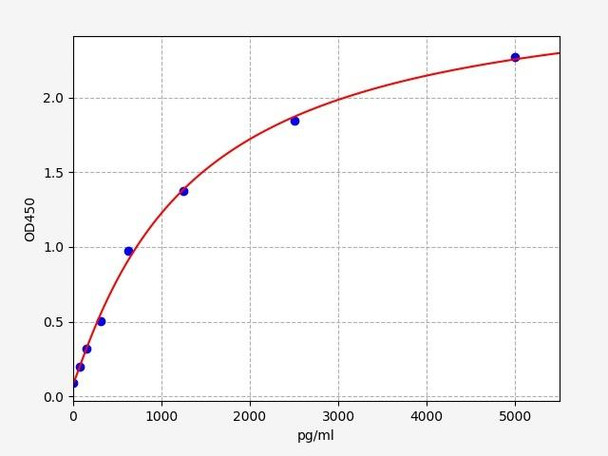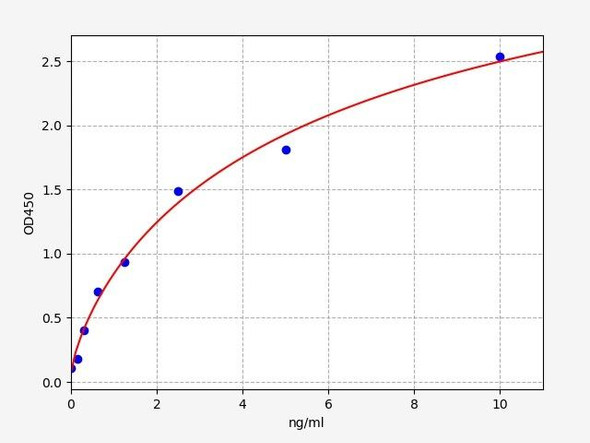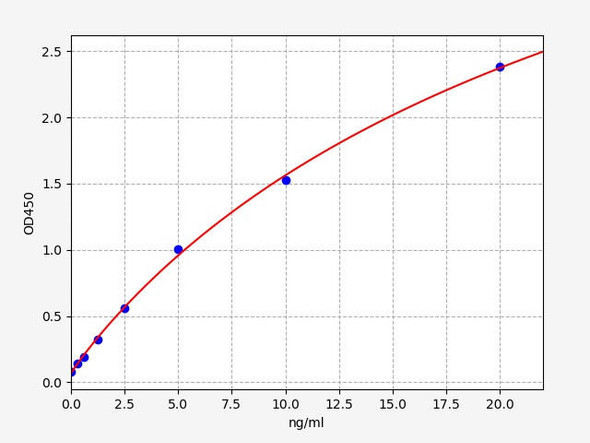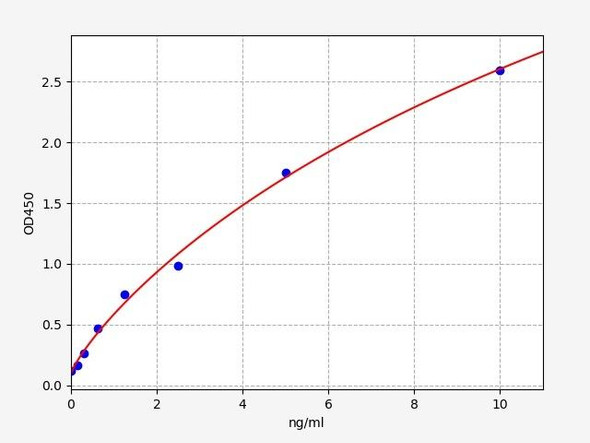Human TYRO3 (Tyrosine-protein kinase receptor TYRO3) ELISA Kit (HUFI08058)
- SKU:
- HUFI08058
- Product Type:
- ELISA Kit
- Size:
- 96 Assays
- Uniprot:
- Q06418
- Sensitivity:
- 46.875pg/ml
- Range:
- 78.125-5000pg/ml
- ELISA Type:
- Sandwich
- Synonyms:
- Tyrosine-protein kinase receptor TYRO3, Tyrosine-protein kinase BYK, Tyrosine-protein kinase DTK, Tyrosine-protein kinase RSE, Tyrosine-protein kinase SKY, Tyrosine-protein kinase TIF, TYRO3, BYK, DTK, RSE, SKY, TIF
- Reactivity:
- Human
Description
Human TYRO3 (Tyrosine-protein kinase receptor TYRO3) ELISA Kit (HUFI08058)
The Human TYRO3 (Tyrosine-protein kinase receptor TYRO3) ELISA Kit is specially designed for the precise measurement of TYRO3 levels in human serum, plasma, and cell culture supernatants. With its exceptional sensitivity and specificity, this kit ensures accurate and consistent results, making it an excellent choice for various research applications.TYRO3 is a vital protein involved in cell signaling pathways, particularly in processes such as cell growth, survival, and immunity.
Dysregulation of TYRO3 has been linked to various diseases, including cancer, autoimmune disorders, and neurodegenerative conditions, highlighting its significance as a biomarker for understanding these diseases and potentially developing targeted therapies.Overall, the Human TYRO3 ELISA Kit from AssayGenie provides researchers with a valuable tool for studying the role of TYRO3 in health and disease, opening up new avenues for research and therapeutic interventions.
| Product Name: | Human TYRO3 (Tyrosine-protein kinase receptor TYRO3) ELISA Kit |
| Product Code: | HUFI08058 |
| Size: | 96 Assays |
| Alias: | Tyrosine-protein kinase receptor TYRO3 ELISA Kit, Tyrosine-protein kinase BYK ELISA Kit, Tyrosine-protein kinase DTK ELISA Kit, Tyrosine-protein kinase RSE ELISA Kit, Tyrosine-protein kinase SKY ELISA Kit, Tyrosine-protein kinase TIF ELISA Kit, TYRO3 ELISA Kit, BYK ELISA Kit, DTK ELISA Kit, RSE ELISA Kit, SKY ELISA Kit, TIF ELISA Kit |
| Detection method: | Sandwich ELISA, Double Antibody |
| Application: | This immunoassay kit allows for the in vitro quantitative determination of Human TYRO3 (Tyrosine-protein kinase receptor TYRO3) concentrations in serum plasma and other biological fluids. |
| Sensitivity: | < 46.875pg/ml |
| Range: | 78.125-5000pg/ml |
| Storage: | 4°C for 6 months |
| Note: | For Research Use Only |
| Recovery: | Matrices listed below were spiked with certain level of Human TYRO3 (Tyrosine-protein kinase receptor TYRO3) and the recovery rates were calculated by comparing the measured value to the expected amount of Human TYRO3 (Tyrosine-protein kinase receptor TYRO3) in samples. | ||||||||||||||||
| |||||||||||||||||
| Linearity: | The linearity of the kit was assayed by testing samples spiked with appropriate concentration of Human TYRO3 (Tyrosine-protein kinase receptor TYRO3) and their serial dilutions. The results were demonstrated by the percentage of calculated concentration to the expected. | ||||||||||||||||
| |||||||||||||||||
| CV(%): | Intra-Assay: CV<8% Inter-Assay: CV<10% |
| Component | Quantity | Storage |
| ELISA Microplate (Dismountable) | 8×12 strips | 4°C for 6 months |
| Lyophilized Standard | 2 | 4°C/-20°C |
| Sample/Standard Dilution Buffer | 20ml | 4°C |
| Biotin-labeled Antibody(Concentrated) | 120ul | 4°C (Protect from light) |
| Antibody Dilution Buffer | 10ml | 4°C |
| HRP-Streptavidin Conjugate(SABC) | 120ul | 4°C (Protect from light) |
| SABC Dilution Buffer | 10ml | 4°C |
| TMB Substrate | 10ml | 4°C (Protect from light) |
| Stop Solution | 10ml | 4°C |
| Wash Buffer(25X) | 30ml | 4°C |
| Plate Sealer | 5 | - |
Other materials and equipment required:
- Microplate reader with 450 nm wavelength filter
- Multichannel Pipette, Pipette, microcentrifuge tubes and disposable pipette tips
- Incubator
- Deionized or distilled water
- Absorbent paper
- Buffer resevoir
| UniProt Protein Function: | Tyro3: Receptor tyrosine kinase that transduces signals from the extracellular matrix into the cytoplasm by binding to several ligands including TUB, TULP1 or GAS6. Regulates many physiological processes including cell survival, migration and differentiation. Ligand binding at the cell surface induces dimerization and autophosphorylation of TYRO3 on its intracellular domain that provides docking sites for downstream signaling molecules. Following activation by ligand, interacts with PIK3R1 and thereby enhances PI3-kinase activity. Activates the AKT survival pathway, including nuclear translocation of NF-kappa-B and up-regulation of transcription of NF-kappa-B-regulated genes. TYRO3 signaling plays a role in various processes such as neuron protection from excitotoxic injury, platelet aggregation and cytoskeleton reorganization. Plays also an important role in inhibition of Toll-like receptors (TLRs)-mediated innate immune response by activating STAT1, which selectively induces production of suppressors of cytokine signaling SOCS1 and SOCS3. Monomer and homodimer. Interacts (via N-terminus) with extracellular ligands TUB, TULP1 and GAS6. Interacts with PIK3R1; this interaction increases PI3-kinase activity. Abundant in the brain and lower levels in other tissues. Belongs to the protein kinase superfamily. Tyr protein kinase family. AXL/UFO subfamily. |
| UniProt Protein Details: | Protein type:Kinase, protein; EC 2.7.10.1; Membrane protein, integral; Protein kinase, TK; Protein kinase, tyrosine (receptor); TK group; Axl family Chromosomal Location of Human Ortholog: 15q15 Cellular Component: endoplasmic reticulum membrane; integral to plasma membrane; nuclear envelope; nucleus Molecular Function:protein binding; protein heterodimerization activity; protein-tyrosine kinase activity; phosphoinositide 3-kinase binding; receptor signaling protein tyrosine kinase activity; transmembrane receptor protein tyrosine kinase activity; ATP binding Biological Process: forebrain cell migration; platelet activation; negative regulation of lymphocyte activation; phosphoinositide 3-kinase cascade; peptidyl-tyrosine phosphorylation; protein amino acid autophosphorylation; vagina development; signal transduction; ovulation cycle; negative regulation of innate immune response; natural killer cell differentiation; negative regulation of inflammatory response; protein kinase B signaling cascade; negative regulation of toll-like receptor signaling pathway; spermatogenesis; negative regulation of neuron apoptosis; cell adhesion; apoptotic cell clearance; secretion by cell |
| NCBI Summary: | The gene is part of a 3-member transmembrane receptor kinase receptor family with a processed pseudogene distal on chromosome 15. The encoded protein is activated by the products of the growth arrest-specific gene 6 and protein S genes and is involved in controlling cell survival and proliferation, spermatogenesis, immunoregulation and phagocytosis. The encoded protein has also been identified as a cell entry factor for Ebola and Marburg viruses. [provided by RefSeq, May 2010] |
| UniProt Code: | Q06418 |
| NCBI GenInfo Identifier: | 1717829 |
| NCBI Gene ID: | 7301 |
| NCBI Accession: | Q06418.1 |
| UniProt Secondary Accession: | Q06418,O14953, Q86VR3, |
| UniProt Related Accession: | Q06418 |
| Molecular Weight: | 96,905 Da |
| NCBI Full Name: | Tyrosine-protein kinase receptor TYRO3 |
| NCBI Synonym Full Names: | TYRO3 protein tyrosine kinase |
| NCBI Official Symbol: | TYRO3 |
| NCBI Official Synonym Symbols: | BYK; Dtk; RSE; Sky; Tif |
| NCBI Protein Information: | tyrosine-protein kinase receptor TYRO3; tyrosine-protein kinase DTK; tyrosine-protein kinase RSE; tyrosine-protein kinase SKY; tyrosine-protein kinase TIF; tyrosine-protein kinase byk |
| UniProt Protein Name: | Tyrosine-protein kinase receptor TYRO3 |
| UniProt Synonym Protein Names: | Tyrosine-protein kinase BYK; Tyrosine-protein kinase DTK; Tyrosine-protein kinase RSE; Tyrosine-protein kinase SKY; Tyrosine-protein kinase TIF |
| UniProt Gene Name: | TYRO3 |
| UniProt Entry Name: | TYRO3_HUMAN |
*Note: Protocols are specific to each batch/lot. For the correct instructions please follow the protocol included in your kit.
Before adding to wells, equilibrate the SABC working solution and TMB substrate for at least 30 min at 37 °C. When diluting samples and reagents, they must be mixed completely and evenly. It is recommended to plot a standard curve for each test.
| Step | Protocol |
| 1. | Set standard, test sample and control (zero) wells on the pre-coated plate respectively, and then, record their positions. It is recommended to measure each standard and sample in duplicate. Wash plate 2 times before adding standard, sample and control (zero) wells! |
| 2. | Aliquot 0.1ml standard solutions into the standard wells. |
| 3. | Add 0.1 ml of Sample / Standard dilution buffer into the control (zero) well. |
| 4. | Add 0.1 ml of properly diluted sample ( Human serum, plasma, tissue homogenates and other biological fluids.) into test sample wells. |
| 5. | Seal the plate with a cover and incubate at 37 °C for 90 min. |
| 6. | Remove the cover and discard the plate content, clap the plate on the absorbent filter papers or other absorbent material. Do NOT let the wells completely dry at any time. Wash plate X2. |
| 7. | Add 0.1 ml of Biotin- detection antibody working solution into the above wells (standard, test sample & zero wells). Add the solution at the bottom of each well without touching the side wall. |
| 8. | Seal the plate with a cover and incubate at 37 °C for 60 min. |
| 9. | Remove the cover, and wash plate 3 times with Wash buffer. Let wash buffer rest in wells for 1 min between each wash. |
| 10. | Add 0.1 ml of SABC working solution into each well, cover the plate and incubate at 37 °C for 30 min. |
| 11. | Remove the cover and wash plate 5 times with Wash buffer, and each time let the wash buffer stay in the wells for 1-2 min. |
| 12. | Add 90 µL of TMB substrate into each well, cover the plate and incubate at 37 °C in dark within 10-20 min. (Note: This incubation time is for reference use only, the optimal time should be determined by end user.) And the shades of blue can be seen in the first 3-4 wells (with most concentrated standard solutions), the other wells show no obvious color. |
| 13. | Add 50 µL of Stop solution into each well and mix thoroughly. The color changes into yellow immediately. |
| 14. | Read the O.D. absorbance at 450 nm in a microplate reader immediately after adding the stop solution. |
When carrying out an ELISA assay it is important to prepare your samples in order to achieve the best possible results. Below we have a list of procedures for the preparation of samples for different sample types.
| Sample Type | Protocol |
| Serum | If using serum separator tubes, allow samples to clot for 30 minutes at room temperature. Centrifuge for 10 minutes at 1,000x g. Collect the serum fraction and assay promptly or aliquot and store the samples at -80°C. Avoid multiple freeze-thaw cycles. If serum separator tubes are not being used, allow samples to clot overnight at 2-8°C. Centrifuge for 10 minutes at 1,000x g. Remove serum and assay promptly or aliquot and store the samples at -80°C. Avoid multiple freeze-thaw cycles. |
| Plasma | Collect plasma using EDTA or heparin as an anticoagulant. Centrifuge samples at 4°C for 15 mins at 1000 × g within 30 mins of collection. Collect the plasma fraction and assay promptly or aliquot and store the samples at -80°C. Avoid multiple freeze-thaw cycles. Note: Over haemolysed samples are not suitable for use with this kit. |
| Urine & Cerebrospinal Fluid | Collect the urine (mid-stream) in a sterile container, centrifuge for 20 mins at 2000-3000 rpm. Remove supernatant and assay immediately. If any precipitation is detected, repeat the centrifugation step. A similar protocol can be used for cerebrospinal fluid. |
| Cell culture supernatant | Collect the cell culture media by pipette, followed by centrifugation at 4°C for 20 mins at 1500 rpm. Collect the clear supernatant and assay immediately. |
| Cell lysates | Solubilize cells in lysis buffer and allow to sit on ice for 30 minutes. Centrifuge tubes at 14,000 x g for 5 minutes to remove insoluble material. Aliquot the supernatant into a new tube and discard the remaining whole cell extract. Quantify total protein concentration using a total protein assay. Assay immediately or aliquot and store at ≤ -20 °C. |
| Tissue homogenates | The preparation of tissue homogenates will vary depending upon tissue type. Rinse tissue with 1X PBS to remove excess blood & homogenize in 20ml of 1X PBS (including protease inhibitors) and store overnight at ≤ -20°C. Two freeze-thaw cycles are required to break the cell membranes. To further disrupt the cell membranes you can sonicate the samples. Centrifuge homogenates for 5 mins at 5000xg. Remove the supernatant and assay immediately or aliquot and store at -20°C or -80°C. |
| Tissue lysates | Rinse tissue with PBS, cut into 1-2 mm pieces, and homogenize with a tissue homogenizer in PBS. Add an equal volume of RIPA buffer containing protease inhibitors and lyse tissues at room temperature for 30 minutes with gentle agitation. Centrifuge to remove debris. Quantify total protein concentration using a total protein assay. Assay immediately or aliquot and store at ≤ -20 °C. |
| Breast Milk | Collect milk samples and centrifuge at 10,000 x g for 60 min at 4°C. Aliquot the supernatant and assay. For long term use, store samples at -80°C. Minimize freeze/thaw cycles. |










